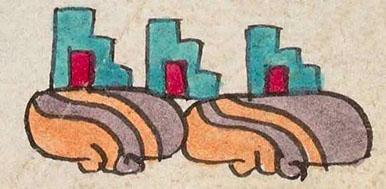Tetenanco (Mdz42r)
This compound glyph for the place name Tetenanco ("At the Ramparts") consists of two large stones and three pieces of ramparts. The stones are horizontal with curving lines cutting through them, curling outcroppings at the bottom, and they are colored purple and orange. The ramparts are vertical, colored red and turquoise, and they are crenellated or stepped.
Stephanie Wood
The way the ramparts are in separate pieces, compared to the usual, joined pieces (see below, right), may represent an effort to point to the reduplication. This is possibly also true of the two stones, instead of just one.
Stephanie Wood
tetenanco. puo
Tetenanco, pueblo
Stephanie Wood
c. 1541, but by 1553 at the latest
Stephanie Wood
stones, piedras, ramparts, walls, crenellation, almena, almenas, merlons, cresterias, paredes, pueblos, altepetl, topónimos, nombres de lugares

te(tl), stone or rock, https://nahuatl.wired-humanities.org/content/tetl
tenan(tli), wall or ramparts, https://nahuatl.wired-humanities.org/content/tenantli
-co (locative suffix), https://nahuatl.wired-humanities.org/content/co
Muro de Piedra
Erik Velásquez García, "Silabogramas nahuas en tiempos de la Conquista," Estudios de Cultura Náhuatl 58(2019), 83.
Codex Mendoza, folio 42 recto, https://digital.bodleian.ox.ac.uk/objects/2fea788e-2aa2-4f08-b6d9-648c00..., image 94 of 188.
The Bodleian Libraries, University of Oxford, hold the original manuscript, the MS. Arch. Selden. A. 1. This image is published here under the UK Creative Commons, “Attribution-NonCommercial-ShareAlike 3.0 License” (CC-BY-NC-SA 3.0).



